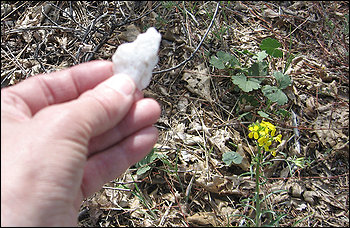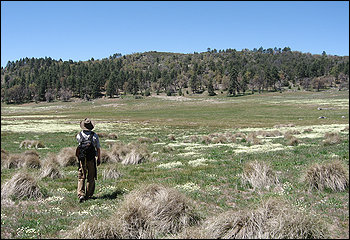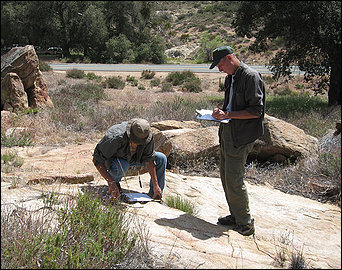Laguna Mountain - Passport in Time
Main menu:
PIT Highlights > Headlines > 2009
A Hike Into the Past: The Laguna Mountain Project
Cleveland National Forest, California, 2009
By Sue Kovach Shuman, Washington Post Staff Writer and PIT Volunteer
Sunday, December 13, 2009
I was attacked by red ants. Sat on a cactus. Almost stepped on a rattlesnake.
And given the chance, I'd take the same vacation again.
For five days last May, I worked as a volunteer archaeologist with the U.S. Forest Service in Southern California's Cleveland National Forest. Through the service's Passport in Time (PIT) program, I located and photographed sites where the native peoples of 12,000 years ago, the Diegueños, carved stone tools and weapons, where 7,500 years ago their descendants ground seeds and nuts on rocks and where more-recent descendants produced pottery.
 (Photo: In Southern California's Cleveland National Forest, evidence of prehistoric sites: arrowheads and ancient tools. Courtsey of Sue Kovach Shuman/The Washington Post)
(Photo: In Southern California's Cleveland National Forest, evidence of prehistoric sites: arrowheads and ancient tools. Courtsey of Sue Kovach Shuman/The Washington Post)My volunteer vacation goals were simple: Go West, to some relatively isolated location. Limit phone and Internet use. And do it cheaply. The Forest Service, an Agriculture Department agency, might be best known for fire protection, but its PIT projects focus on archaeology and historic preservation, from excavating prehistoric ovens to repairing structures built in the 1930s by the Civilian Conservation Corps. I applied to four projects, hoping to learn archaeology while contributing sketching and photography skills.
Cleveland Forest archaeologist Susan Roder selected me for "A Hike Into the Past: The Laguna Mountain Project" and sent homework: papers titled "Recognizing Prehistoric Artifacts," "Bedrock Processing Features" and "Southern California Ceramics." I studied on the Metro, trying to discern a mano (a grinding rock) from a metate (a milling stone).
On the first day, Roder warned volunteers about the hardships we might encounter: dehydration, thorns, ticks. We'd tote compasses, GPS devices, trowels and cameras up to four miles to reach sites, she told us. The 460,000-acre forest stretches nearly 100 miles, from the Santa Ana Mountains in Orange County to the Laguna Mountains at the Mexican border. Parts of the Cleveland are remote, yet San Diego's beaches are only an hour's drive from one entrance to the forest. There are 127 miles of trails, and over the years, people have left their mark.
Still, you might see more critters than people. In the visitor center run by the nonprofit Laguna Mountain Volunteer Association (LMVA), I saw Tecumseh, a stuffed mountain lion. In the wild, we saw coyotes, rattlesnakes, turkeys and scorpions. There isn't much in the forest except nature, and it seemed out to get me, indoors or out.
LMVA owns the Red-Tailed Roost, where I stayed, on Sunrise Highway atop 6,000-foot Mount Laguna. In the 1950s, it was a school for children of service members based at Mount Laguna Air Station, part of the Cold War defense system. I stoked the Roost's wood stove -- until I saw spiders in the woodpile. In the walls near my bunk bed, one of 18, I could hear mice scurrying.
Since 2004, 74 volunteers have worked on the project, especially around 750-acre Laguna Meadow, which Roder called "the crown jewel" because it has yielded so many artifacts. The meadow was once a major travel corridor between the desert and the coast, as well as into Baja California. It's surrounded by pine, cedar and oak trees, and several villages once stood there. You wouldn't know it today.
"Virtually hundreds of places have been picked over by people through the years," Roder said.
She asked volunteers to keep locations secret and, tempting though it was, not to pocket artifacts (which is prohibited by federal law).
In 1981, a Forest Service survey identified 152 prehistoric and historic sites in the Cleveland for nomination to the National Register of Historic Places. The nominations weren't made at that time, but the effort has now been renewed. Roder said her plan was to take all the data we found in the meadow and put together a nomination. A listing in the National Register could lead to funding for more research. "There is still much to be learned about the prehistory of San Diego County," Roder said, "and research could provide some answers to questions about settlement patterns, trade networks, resource uses."
For the project we were working on, Roder said, she had about $12,800, which paid for two archaeologists plus a student intern and supplies.
 (Photo: Tim Wolfe, an archaeology student who works as an intern in Cleveland National Forest, walks through Big Laguna Meadow, trying to avoid cactus flowers and snake holes while searching for ancient sites. Courtsey of Sue Kovach Shuman/The Washington Post)
(Photo: Tim Wolfe, an archaeology student who works as an intern in Cleveland National Forest, walks through Big Laguna Meadow, trying to avoid cactus flowers and snake holes while searching for ancient sites. Courtsey of Sue Kovach Shuman/The Washington Post)
 (Photo: Volunteers David Loera and Tom Davis measure a rock that was once used for milling. Courtsey of Sue Kovach Shuman/The Washington Post)
(Photo: Volunteers David Loera and Tom Davis measure a rock that was once used for milling. Courtsey of Sue Kovach Shuman/The Washington Post)
My group of volunteers included David Loera of Sacramento, a retired surveyor; Penny Mortier, an Albuquerque college instructor; Wij Galloway of Malibu, Calif., a participant for six years; Chuck Griswold of Carlsbad, Calif., a five-year participant; and Tom Davis of Lakeside, Calif., a past president of LMVA.
 (Photo: Tim Wolfe, an archaeology student who works as an intern in Cleveland National Forest, walks through Big Laguna Meadow, trying to avoid cactus flowers and snake holes while searching for ancient sites. Courtsey of Sue Kovach Shuman/The Washington Post)
(Photo: Tim Wolfe, an archaeology student who works as an intern in Cleveland National Forest, walks through Big Laguna Meadow, trying to avoid cactus flowers and snake holes while searching for ancient sites. Courtsey of Sue Kovach Shuman/The Washington Post)On Monday, the first day of the project, we hiked into the forest after a brief orientation at the Roost. We were looking for milling sites, large rocks where native peoples used stone tools to grind seeds and nuts into food. All the other volunteers quickly recognized "used" rocks -- rocks that had been altered by human activity. But unless there were pockmarks or depressions an inch deep, I didn't. Most befuddling was a slick, a polished rock worn smooth from years of having nuts or seeds ground on its surface.
"Basically, you're feeling rocks," Galloway explained, assuring me that "you get better at it."
 (Photo: Volunteers David Loera and Tom Davis measure a rock that was once used for milling. Courtsey of Sue Kovach Shuman/The Washington Post)
(Photo: Volunteers David Loera and Tom Davis measure a rock that was once used for milling. Courtsey of Sue Kovach Shuman/The Washington Post)Most of the milling sites were once near water but have been dry for thousands of years. Still, cactus sprouts from crevices, and more than once that day, I sat on some.
Over spaghetti dinner that night, I learned that Griswold, 80, has hiked the forest for 40 years. Everyone had been on PIT projects before. I had nightmares of Geology 101 classes at Penn State; after that course, I think all I was able to identify were volcanic rock and coal-mine anthracite. While others slept, I studied the mini-museum of arrowheads, ancient tools and pottery pieces that Roder had left on a table in the Roost.
Tuesday, working in teams of two, we scrambled along a creek looking for evidence of human habitation. Everyone delighted in showing things to Roder. With beginner's luck, I picked up a prehistoric tool -- and dropped it in tall grass. "That happens," Roder said with a sigh. I concentrated on taking photos.
Over breakfast Wednesday, I learned that a rattlesnake had once bitten a volunteer's boot. Our prime directive was: Leave rattlesnakes alone. Watch where you step, Roder cautioned -- but also watch what's above. It sounded easy, yet I repeatedly walked into tree limbs.
In parts of the mountains, private ranches coexist with national forest. To reach some sites, we drove past peacock-patrolled farms. Temperatures hit the mid-90s. Something bit my neck while I was standing amid mammoth boulders, concentrating on getting accurate GPS numbers at a milling site. Red ants were swarming me, running up my legs to my arms and face; I was standing atop their gigantic mound. Roder and Galloway swatted at me. I flailed, trying to dislodge ants in places I didn't want to think about. It lasted about a minute, one of the longest of my life. But I never dropped the GPS device.
That afternoon, a U.S. Customs and Border Protection helicopter circled above as we worked in an area close to the Mexican border where illegal immigrants try to hide amid the scrubby brush. We found discarded clothes, backpacks and bottles, as well as evidence of earlier habitation. Circling wider and wider, we discovered a pottery-making site.
Then we spent hours wandering, unable to find a site from the earlier survey. Disappointed, I led the way back to our vehicles, forging a path through sticks, one of which suddenly moved. My foot landed an inch from a rattlesnake. It protested loudly, shaking its tail. Cursing, I crashed backward into Roder while the snake slithered into a bush. "Ha! You scared him!" Griswold said, laughing.
That evening, I finally relaxed with my colleagues over popcorn and a movie, "The Greater Good," a Forest Service history.
My vacation was like camp for adults: up by 7 a.m., lights out by 10 p.m. Dinners were simple: I made zucchini frittatas, Loera brought homemade chili. In the evenings, everyone read or talked. Cellphones? Off.
On Friday, we cleaned the Roost. Everybody clapped as Roder presented me with my green PIT passport, noting 40 hours of work (which the Forest Service values at $20 an hour).
My week-long vacation cost just $541 (including airfare, car rental, a hotel night and groceries). I'd learned about what it takes to be an archaeologist -- about patience, documentation and the joy of small discoveries.
If I'm invited back, I'll tread carefully around the artifacts, of course -- but also because a napping rattlesnake can look just like a stick.